
- News
- Basics
- Products
- JP Job shop
- Exhibition
- Interview
- Statistic
- PR
- Download
- Special contents
Statistic
May 15, 2023
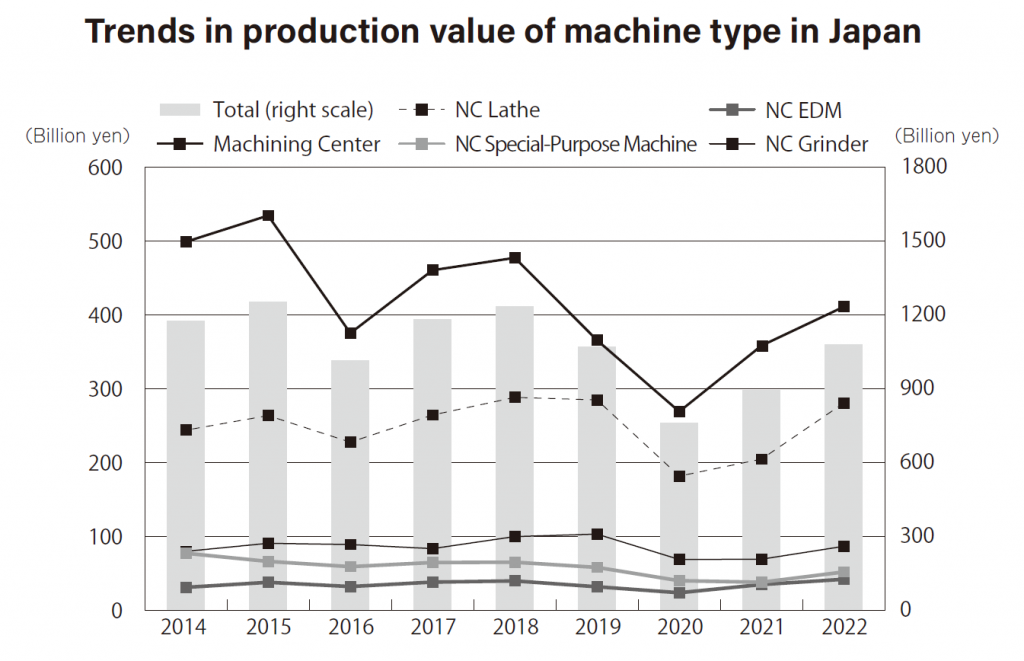
The supply and demand results for the machine tool industry in Japan for the year 2022 have been compiled.
According to the Machinery Statistics of the Ministry of Economy, Trade and Industry of Japan (METI), the production of machine tools increased by 20.5% year-on-year (YoY) to 1,078.833 billion yen. The Japan Machine Tool Builders’ Association (JMTBA) also announced that the total amount of orders received in 2022 was 1,759.601 billion yen, up 14.2% YoY and the second highest in history. Although there is still a large gap between the amount of production and the amount of orders, the recovery from the COVID-19 pandemic was evident.
 According to METI’s Machinery Statistics, machine tool production increased for the second consecutive year in 2022, up 20.5% YoY to 1,078.833 billion yen. Of this amount, NC machine tools also recorded an increase of 21.5% to 1,013.096 billion yen, with the ratio of NC machine tools reaching a record high of 93.9%. The production value exceeded 1 trillion yen for the first time in three years.
According to METI’s Machinery Statistics, machine tool production increased for the second consecutive year in 2022, up 20.5% YoY to 1,078.833 billion yen. Of this amount, NC machine tools also recorded an increase of 21.5% to 1,013.096 billion yen, with the ratio of NC machine tools reaching a record high of 93.9%. The production value exceeded 1 trillion yen for the first time in three years.
By machine type, machining centers (MCs), which had the highest production value, increased 14.6% YoY to 411.5 billion yen. The amount exceeded 400 billion yen for the first time in four years, reflecting the strong demand for semiconductor-related applications that continued from last year.
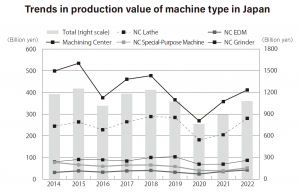 Broken down further, the amount of vertical MCs increased for the second consecutive year, up 3.9% YoY to 232.874 billion yen, while the number of units decreased for the first time in three years, down 13.0% YoY. While the production value of vertical MCs increased only slightly, that of horizontal MCs increased 34.8% YoY to 145.956 billion yen, maintaining the same high growth rate as in 2021. Among MCs, the production value of vertical MCs with front-to-back strokes of 500 mm or more increased 31.4% YoY, while the production value of horizontal MCs with table sizes of 500 mm or more increased 41.3% YoY, reflecting the high demand for large workpieces. Both the production value and volume of other MCs also exceeded the previous year’s levels.
Broken down further, the amount of vertical MCs increased for the second consecutive year, up 3.9% YoY to 232.874 billion yen, while the number of units decreased for the first time in three years, down 13.0% YoY. While the production value of vertical MCs increased only slightly, that of horizontal MCs increased 34.8% YoY to 145.956 billion yen, maintaining the same high growth rate as in 2021. Among MCs, the production value of vertical MCs with front-to-back strokes of 500 mm or more increased 31.4% YoY, while the production value of horizontal MCs with table sizes of 500 mm or more increased 41.3% YoY, reflecting the high demand for large workpieces. Both the production value and volume of other MCs also exceeded the previous year’s levels.
Other notable models that increased from the previous year were lathes, up 35.6% YoY to 305.953 billion yen; grinders, up 24.6% YoY to 104.104 billion yen; and NC electric discharge machines, up 20.0% YoY to 42.438 billion yen.
The domestic consumption value (production value + import value – export value) in the supply-demand overview increased 26.0% YoY to 306.689 billion yen, the first increase in four years.
According to JMTBA, total machine tool orders in 2022 increased 14.2% YoY to 1,759.601 billion yen, exceeding 1 trillion yen for the second consecutive year.
The recovery trend from 2021 continued, with carryover demand from the pandemic, demand for semiconductor-related applications, and demand for electric vehicle (EV)-related applications increasing. As a result, orders surpassed 2021, which was the fourth-highest year on record and the second-highest year on record.
On a single-month basis, orders never fell below 130 billion yen and remained at a higher level than the previous year.
Domestic demand rose 18.2% YoY to 603.231 billion yen, exceeding 600 billion yen for the first time in 4 years. Until around September, subsidies drove demand for automation to meet increased production capacity due to parts shortages, etc. Orders remained at around 50 billion yen per month, including a record 60.2 billion yen in March. Since October, however, the market has become more cautious due to rising interest rates in Europe and the U.S. and uncertainty about the future due to inflation. The 31st Japan International Machine Tool Fair (JIMTOF2022) was held in November, but it did not have such a dynamic impact.
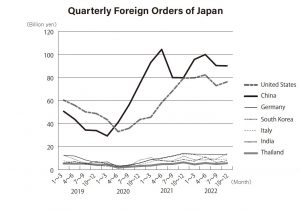 Foreign demand increased 12.1% YoY to 1,156.37 billion yen, exceeding 1 trillion yen for the second consecutive year. Total orders received exceeded 1.1 trillion yen for the first time ever, reaching a record high. Orders from the three major regions of Asia, North America and Europe were all higher than the previous year. Orders from Asia increased for the second consecutive year, rising 7.6% YoY to 556.7 billion yen, surpassing the 550 billion yen mark for the first time and setting a new record. Taiwan and China set new records for the second consecutive year. The rest of Asia increased 21.2% YoY to 110.9 billion yen, exceeding 100 billion yen for the first time in four years.
Foreign demand increased 12.1% YoY to 1,156.37 billion yen, exceeding 1 trillion yen for the second consecutive year. Total orders received exceeded 1.1 trillion yen for the first time ever, reaching a record high. Orders from the three major regions of Asia, North America and Europe were all higher than the previous year. Orders from Asia increased for the second consecutive year, rising 7.6% YoY to 556.7 billion yen, surpassing the 550 billion yen mark for the first time and setting a new record. Taiwan and China set new records for the second consecutive year. The rest of Asia increased 21.2% YoY to 110.9 billion yen, exceeding 100 billion yen for the first time in four years.
On a single-month basis, the high level seen since the beginning of the year was maintained, with only two months during the year, August and November, falling below 90 billion yen. Demand for teleworking-related products in China, which had supported foreign demand in the previous year, and large orders for contract production of electronic equipment were largely absent, but demand for semiconductor-related and EV-related products, as well as investment to achieve automation, was strong. Investment in semiconductor-related and automation-related applications was also notable in Europe and North America.
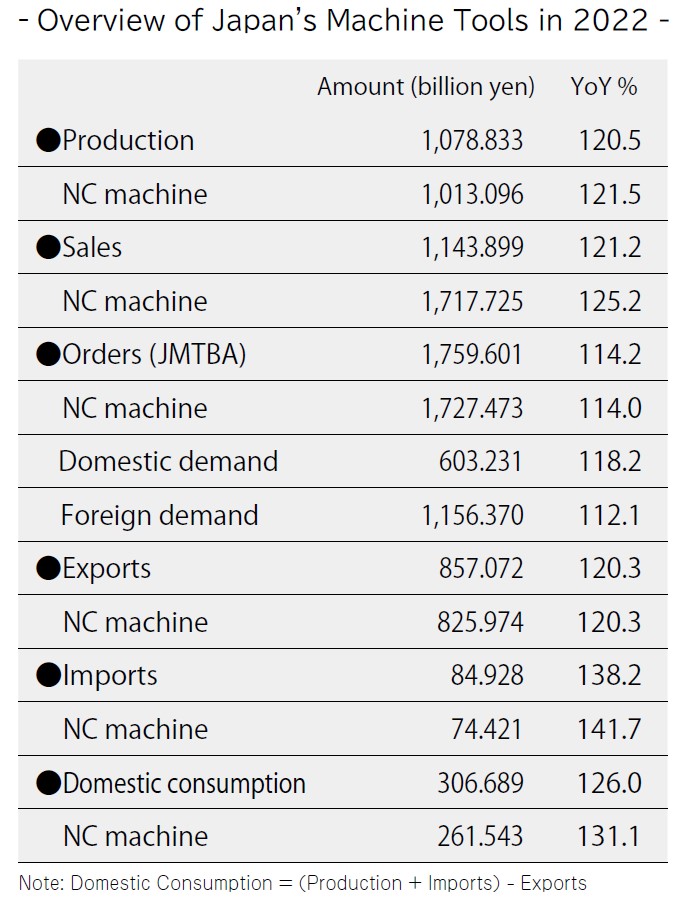

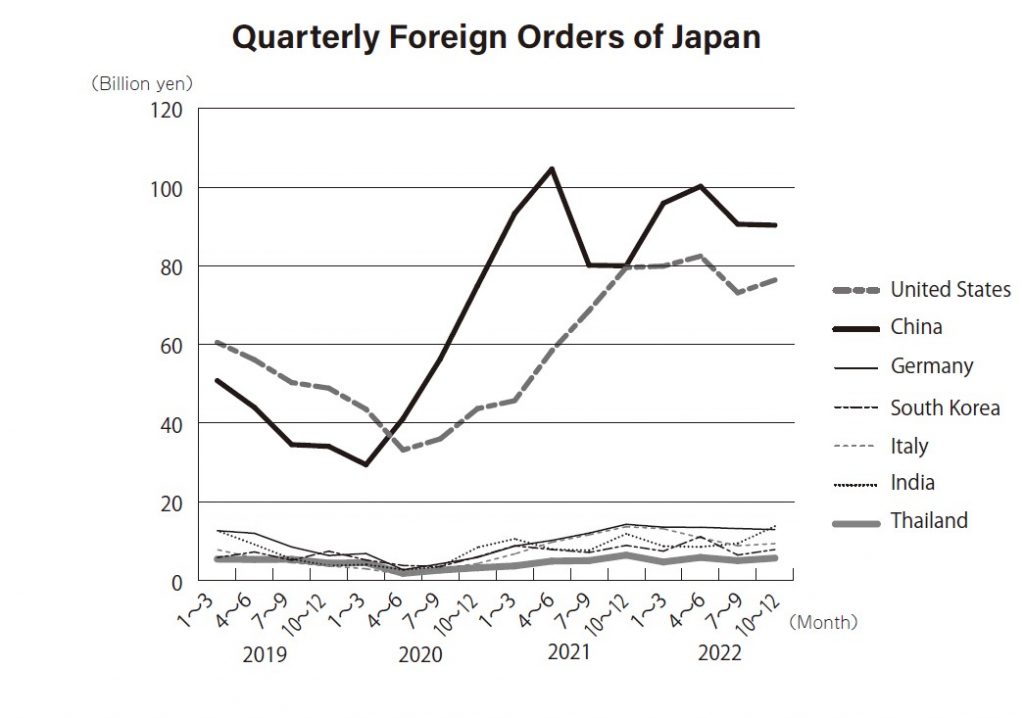
September 2, 2025